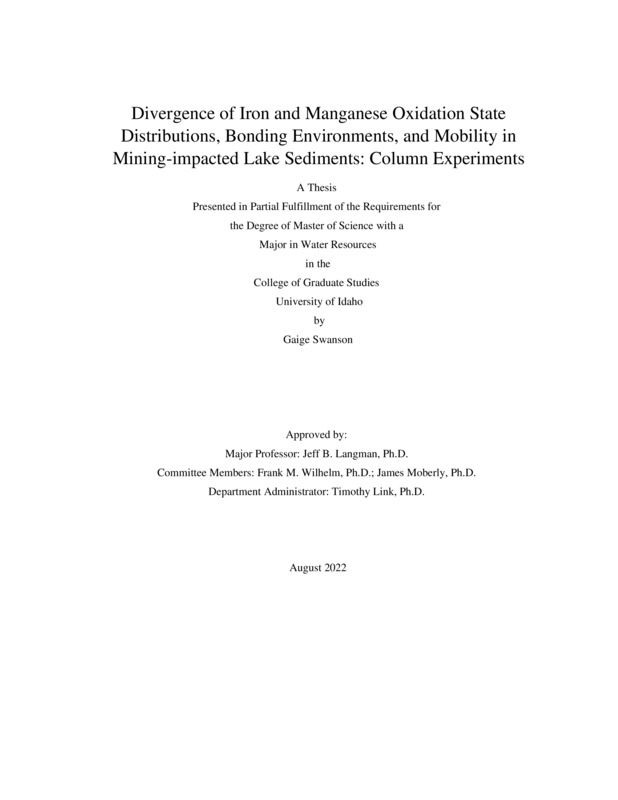Divergence of iron and manganese oxidation state distributions, bonding environments, and mobility in mining-impacted lake sediments: column experiments
Swanson, Gaige. (2022-08). Divergence of iron and manganese oxidation state distributions, bonding environments, and mobility in mining-impacted lake sediments: column experiments. Theses and Dissertations Collection, University of Idaho Library Digital Collections. https://www.lib.uidaho.edu/digital/etd/items/swanson_idaho_0089n_12460.html
- Title:
- Divergence of iron and manganese oxidation state distributions, bonding environments, and mobility in mining-impacted lake sediments: column experiments
- Author:
- Swanson, Gaige
- Date:
- 2022-08
- Keywords:
- bonding environment Iron Manganese Mining Oxidation X-ray Absorption Spectroscopy
- Program:
- Water Resources
- Subject Category:
- Water resources management; Environmental science; Environmental geology
- Abstract:
-
The mobility of a metal in mining-impacted sediments is determined by the environmental conditions that influence the metal’s oxidation state and bonding environment. Coeur d’Alene Lake of northern Idaho, USA, has been impacted by legacy mining practices that allowed the hydrologic transport of mining waste to the lakebed, which resulted in the deposition of an estimated 75 Mt of metal(loid)-rich sediments containing As, Cd, Fe, Mn, Pb, and Zn over the past 100+ years. Future lake conditions may include substantial algal blooms and deposition of additional algal detritus to the sediment-water interface, which may alter metal remobilization/retention during seasonal anoxia. Cores of the lake sediments were exposed to anoxic and anoxic + algae conditions for eight weeks. Over the eight-week period and at a location 12.5 cm deep in the sediments, anoxic and anoxic + algae conditions produced relatively stable Fe and Mn oxidation states and bonding environments. At a location 2.5 cm below the sediment-water interface, anoxic conditions promoted a relatively stable environment in which Fe and Mn oxidation states did not vary greatly during the experiment. At the 2.5-cm depth, the anoxic + algae condition substantially altered the Mn oxidation state distribution and bonding environment, but this condition did not strongly influence the Fe oxidation state distribution or bonding environment. The addition of algal detritus increased the presence of Mn3+, at select times produced Mn4+, altered the Mn bonding environment, and induced a larger release of Mn from the sediments into porewater. This increased oxidation of Mn, change in Mn bonding environment, and additional release of Mn from the sediments under the anoxic + algae condition likely occurred because of the increased formation of organo-Mn complexes produced during enhanced enzymatic processes with the presence of the additional organic matter. The increased microbial activity and Mn mobility has the potential to increase the release of Mn from the sediments and into the lake water column.
- Description:
- masters, M.S., Water Resources -- University of Idaho - College of Graduate Studies, 2022-08
- Major Professor:
- Langman, Jeff
- Committee:
- Wilhelm, Frank; Moberly, James; Link, Tim
- Defense Date:
- 2022-08
- Identifier:
- Swanson_idaho_0089N_12460
- Type:
- Text
- Format Original:
- Format:
- application/pdf
- Rights:
- In Copyright - Educational Use Permitted. For more information, please contact University of Idaho Library Special Collections and Archives Department at libspec@uidaho.edu.
- Standardized Rights:
- http://rightsstatements.org/vocab/InC-EDU/1.0/

